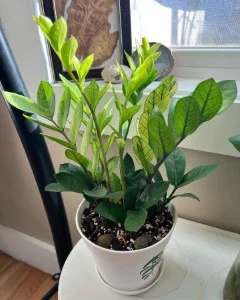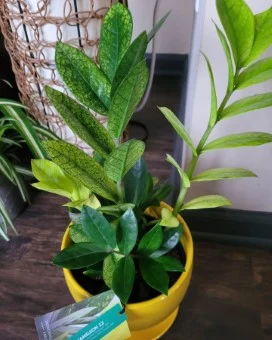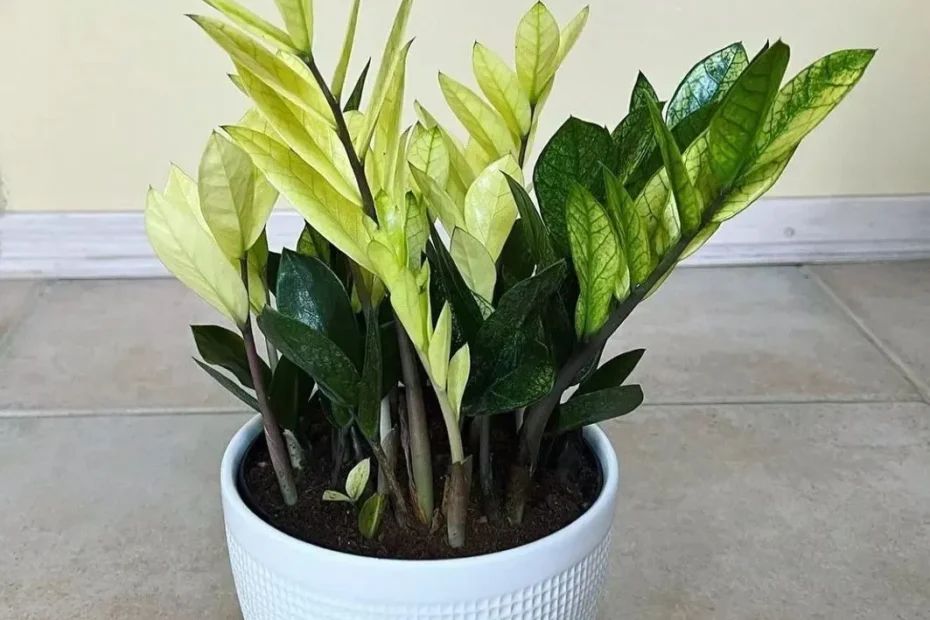Introduction
Imagine a plant that evolves with the passing of seasons, subtly shifting its hues to match the ambient light—meet the Chameleon ZZ Plant, a remarkable specimen within the horticultural world. Unlike any other, this plant flaunts its dynamic nature through color transformation, an enthralling spectacle for any observer. Its low-maintenance qualities, coupled with an innate resilience to less-than-ideal conditions, make it an ideal companion for both seasoned gardeners and those new to the botanical realm. I, a fervent plant enthusiast and gardener for over a decade, have witnessed firsthand the simplicity and joy of nurturing these living wonders. The Chameleon ZZ Plant stands out not only for its aesthetic appeal but also for its ability to thrive with minimal care, offering a rewarding experience for beginners eager to dip their toes into the vast ocean of gardening.
Unveiling the Chameleon ZZ: Origin and Characteristics
Origin and Scientific Background
The Chameleon ZZ Plant, scientifically known as Zamioculcas zamiifolia, is a distinctive member of the Araceae family. This intriguing plant traces its origins back to the eastern regions of Africa, where it flourishes in a variety of environmental conditions, demonstrating unparalleled resilience. Its ability to withstand periods of drought and thrive in low-light conditions is attributed to its robust root system, which effectively stores water, ensuring survival in the unpredictable African climates.
One of the most captivating features of the Chameleon ZZ Plant is its unique color-changing foliage. Initially, new growth presents itself in a striking light green shade, displaying a vivid contrast against the darker, mature leaves. Over time, as the foliage ages, it undergoes a gradual transformation to a deep, rich green, adding to the plant’s dynamic charm. This natural transition in color not only highlights the plant’s adaptability but also its evolving beauty, making it a fascinating subject for study and admiration. The Chameleon ZZ’s capability to adapt its coloring, coupled with its minimal care requirements, encapsulates the essence of resilience and simplicity, mirroring the diverse and adaptive nature of the African flora from which it originates.
Mastering the Art of Chameleon ZZ Care
Light Requirements
The Chameleon ZZ Plant exhibits an admirable level of adaptability when it comes to light conditions, but it reveals its true vibrancy and growth potential under bright, indirect light. To harness its full beauty, it’s advisable to place it near a window where it can bask in ample natural light without the risk of scorching under the harsh rays of direct sunlight. For homes that struggle with natural light, grow lights can serve as an excellent alternative, offering a controlled environment for your plant to thrive. Remember, the Chameleon ZZ’s adaptability includes tolerating lower light conditions, but its foliage will be most vibrant when treated to its preferred lighting.
Watering Wisdom
Following a “less is more” philosophy proves paramount in the watering regimen of the Chameleon ZZ Plant. Its drought-resistant nature calls for well-draining soil that mimics its native habitat, allowing the soil to completely dry out between waterings. Overzealous watering is often more detrimental than neglect; watch out for yellowing leaves as a telltale sign of overwatering, while wilting can indicate underwatering. Adjust watering schedules based on seasonal changes, scaling back in winter months when the plant’s growth naturally slows.


Soil Secrets
A well-draining potting mix, predominantly used for cacti or succulents, lays the foundation for a thriving Chameleon ZZ Plant. This specialized soil caters to the plant’s need for dry conditions between waterings, safeguarding against the bane of many houseplants: root rot. Good drainage is not just a preference but a necessity for maintaining healthy roots and by extension, a healthy plant.
Fertilizing for Success
Given its slow-growing demeanor, the Chameleon ZZ Plant demands minimal feeding. If you choose to fertilize, do so sparingly with a balanced, diluted solution during its active growing seasons in spring and summer. This gentle approach supports its growth without overwhelming it, keeping in line with the overall theme of simplicity and low maintenance that characterizes Chameleon ZZ care.
Beyond the Basics: Pro Tips for a Thriving Chameleon ZZ
Temperature and Humidity
The Chameleon ZZ Plant thrives in the average household temperature range of 60°F to 75°F (15°C to 24°C), perfectly aligning with common indoor settings. It bears a noteworthy tolerance to fluctuations within this range, making it an adaptable companion for various home environments. Humidity levels typical of indoor spaces also suit the Chameleon ZZ well, underscoring its undemanding nature. However, it’s important to avoid placing it in extremely cold drafts or directly in the path of heating vents, as extremes in temperature can stress the plant.
Maintaining Luster
To maintain the enchanting luster of the Chameleon ZZ’s foliage, regular cleaning with a damp cloth is recommended. Gently wipe each leaf to remove dust and other particles, which not only enhances the plant’s natural shine but also supports its photosynthesis efficiency. This simple act of care can keep your plant looking vibrant and healthy, reflecting its dynamic beauty within your indoor space.
Propagation Techniques (Optional)
For gardening aficionados eager to expand their collection, propagating the Chameleon ZZ Plant through rhizome division is a feasible, albeit more advanced, technique. This method involves carefully splitting the plant’s underground rhizome, ensuring each section has at least one growth point. It is crucial to approach this process with caution, as improper division can harm the plant. Additionally, always use clean, sharp tools to minimize the risk of infection.
Benefits of Chameleon ZZ plant
Air purification: Just like other ZZ plants, the Chameleon ZZ plant helps remove toxins from the air, including xylene, toluene, and carbon dioxide. These toxins can come from things like paint, cleaning products, and even furniture.
Low maintenance: This plant is perfect for people who forget to water their plants or don’t have a lot of time to care for them. It can tolerate low light, low humidity, and infrequent watering.
Beautiful foliage: The Chameleon ZZ plant is known for its beautiful, glossy leaves. The new leaves emerge a bright shade of golden yellow before maturing to a rich, dark green. This gives the plant a unique and eye-catching appearances
Easy to grow: Even if you don’t have a lot of experience with plants, you can still grow a Chameleon ZZ plant successfully. It’s a great choice for beginner’s
Fast growing: With proper care, the Chameleon ZZ plant can grow up to 4 feet tall or more. This makes it a great option for people who want a large, statement-making plant for their home.
Troubleshooting Common Issues
Despite its hardy nature, the Chameleon ZZ Plant can occasionally encounter issues such as brown spots on leaves, often a sign of excess moisture. Ensure proper watering practices and adequate drainage to prevent this problem. Pests, while rare, can sometimes afflict the plant. If noticed, gently treating the affected areas with neem oil can provide an organic solution to this issue. Regular inspection and prompt action can prevent these concerns from compromising the health and beauty of your Chameleon ZZ Plant.
Conclusion
In sum, the Chameleon ZZ Plant flourishes with minimal effort, making it an ideal choice for both seasoned and novice gardeners. Key takeaways for successful care include placing it in bright, indirect light, watering sparingly, using well-draining soil, and providing occasional diluted fertilization. Adherence to these guidelines along with maintaining a stable indoor temperature and humidity will ensure your Chameleon ZZ remains a captivating feature in your home. We’d love to see how your Chameleon ZZ plants are thriving! Share pictures and any questions you might have in the comments section below. Your insights and experiences can inspire and help fellow plant enthusiasts!
